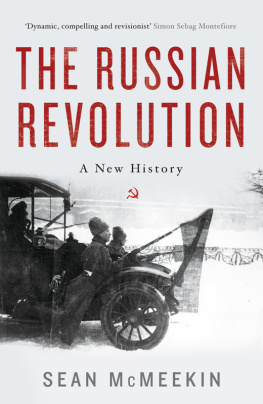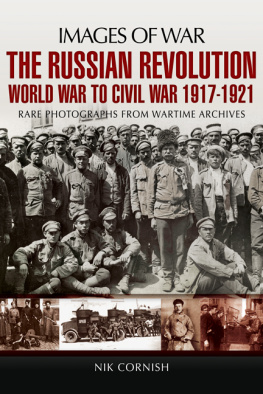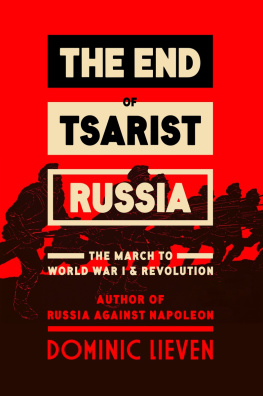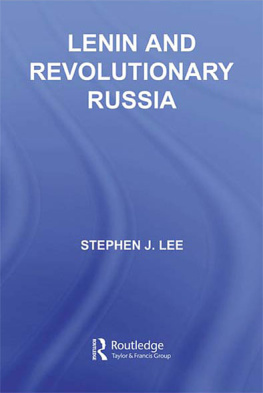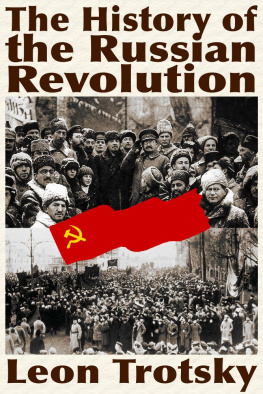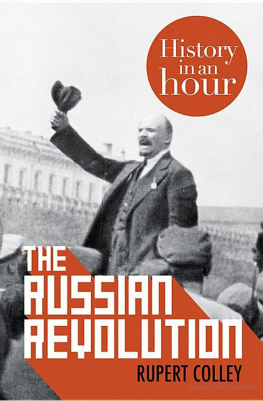More Advance Praise for The Russian Revolution
This is a book that we have been waiting for. The Russian Revolution is an enormous subject, and to write a short and authoritative book on it is very difficult indeed. Sean McMeekin brings many gifts to the task, not the least of which is that he can describe crowd scenes with immediacy. It should count as a classic.
NORMAN STONE, author of The Eastern Front 19141917
In vivid colors, Sean McMeekin presents a provocative narrative of the 1917 Russian revolutions with an emphasis on the conspiracies, mutinies, and acts of treason behind the scenes of both revolutions. He shows how the revolutions were a direct result of Russias involvement in World War I in new ways. It is a book that will generate much debate.
ERIC LOHR, Susan Carmel Lehrman Chair of Russian History and Culture, American University
SEAN MCMEEKIN is Professor of History at Bard College, New York. For some years he taught at Bilkent University, Istanbul. His books include the highly successful The BerlinBaghdad Express (Penguin), The Russian Origins of the First World War and July 1914.
THE RUSSIAN REVOLUTION
THE RUSSIAN REVOLUTION
A New History

SEAN McMEEKIN

First published in Great Britain in 2017 by
Profile Books Ltd
3 Holford Yard
Bevin Way
London
WC1X 9HD
www.profilebooks.com
First published in the United States of America by
Basic Books, an imprint of Perseus Books, LLC,
a subsidiary of Hachette Book Group, Inc.
Copyright Sean McMeekin, 2017
The moral right of the author has been asserted.
All rights reserved. Without limiting the rights under copyright reserved above, no part of this publication may be reproduced, stored or introduced into a retrieval system, or transmitted, in any form or by any means (electronic, mechanical, photocopying, recording or otherwise), without the prior written permission of both the copyright owner and the publisher of this book.
A CIP catalogue record for this book is available from the British Library.
eISBN 978 1 78283 379 6
For Ayla and Errol
A NOTE ON DATES, NAMES, TRANSLATION, AND TRANSLITERATION
The Russian Revolution, like both of the twentieth-century world wars, wrought havoc with place names as cities and entire regions changed hands between empires, from empires to nation states, and sometimes back to empires again. Moscow, mysteriously, escaped the nomenclature revolution, but this is one mercy among endless headaches. Because St. Petersburg was Petrograd (and not yet Leningrad) from 1914 to 1924, that is what it is for most of the book. With other cities I have used the contemporary form with modern usage in parentheses, thus Reval (Tallinn). In more politically sensitive cases, I have offered three versions on first usage, as in Lemberg (Lvov/Lviv). Todays Istanbul was called Constantinople in the period covered in the book, even by Ottoman government officials, and so that is the name we use. Although the Republic of Turkey did not come into formal existence until 1923, I refer to Turkey and the Ottoman Empire interchangeably before that date, as many Turks and most Russians and Europeans did at the time.
Dates provide an especially vexing problem in modern Russian history, in that the Julian calendar the empire used was first twelve, then thirteen days, behind the Gregorian one used in the West, to which the Bolsheviks switched in January 1918, right in the middle of the Russian revolutionary drama. For dates prior to this important in both Russian and European history I have tried to give both dates with a slash, as in November 1/14, 1916, where 1 is the Julian and 14 the Gregorian date. In 1917, when dates start coming fast and furious and the specifically Russian context becomes paramount, I switch over to the Julian calendar owing to the importance of months in revolutionary terminology (February Revolution, April and July days, October Revolution), before following the Bolsheviks in switching to the Gregorian in mid-January 1918. To guide readers, signposts will be offered when these switches are made.
For Russian-language words, I have used the Library of Congress transliteration system, with a somewhat modified version for names. It has been my customary practice in the past to make exceptions only for standard spellings of famous surnames (e.g., Milyukov, not Miliukov). And yet this seems unfair to others. With apologies to Russian specialists, I have applied these changes broadly in the main text, starting Russian names with Yu, not Iu (Yusupov, not Iusopov) and Ya, not Ia (Yakov, not Iakov), which rule also eliminates double initials for first names and patronymics (Iu and Ia are two letters in Latin, one letter in Cyrillic). I have also ended names with -y, not ii (Trotsky, not Trotskii) and -x, not ks (Felix, not Feliks). I have done likewise with names where a close English rendering is common, such as Alexander (not Aleksandr) and Peter (not Petr/Pyotr). Mikhail and Nikolai are spelled and pronounced differently enough in Russian that I have left these alone, unless affixed to an Anglicized title, such as Grand Duke Michael or Grand Duke Nicholas. In accordance with convention, I have also used Izvestiya not Izvestiia and Novoe Vremya not Vremia in the main text, although following Library of Congress spellings in the source notes. Soft and hard signs are left out of the main text, so as not to burden the reader. The goal is to make it as easy as possible to read Russian names, and to remember them. It is impossible to be consistent in all these things; may common sense prevail.
All translations from the French, German, Russian, and Turkish, unless I am citing another translated work or note otherwise, are my own.
INTRODUCTION: THE FIRST CENTURY OF THE RUSSIAN REVOLUTION
L ike 1789, when the French Revolution erupted, 1917 has entered the lexicon of world-historical dates all educated citizens are expected to know and remember. The meaning of 1917, however, remains much contested, not least because two very different revolutions took place in Russia that fateful year. The February Revolution toppled the Russian monarchy and ushered in a brief era of mixed liberal and socialist governance, only to be superseded by the more radical October Revolution, which saw Lenins Bolshevik Party impose a Communist dictatorship and proclaim an open-ended world revolution against capitalism and imperialism. Each of these developments was significant enough to merit serious historical study. Together they constitute one of the seminal events of modern history, which introduced Communism to the world and paved the way for decades of ideological conflict, culminating in the Cold War of 19451991.
Because the Bolsheviks were avowed Marxists, our understanding of the Russian Revolution has long been colored by Marxist language, from the idea of a class struggle between proletarians and the capitalist ruling classes, to the dialectical progression from a bourgeois to a socialist revolution. Even many non-Marxist historians tended, in the Cold War years, to accept the basic Marxist framework of discussion about the Russian Revolution, concentrating on such matters as Russias economic backwardness vis--vis more
This relatively uncritical approach to the Russian Revolution proved surprisingly resistant to revision over the decades, in part because the great anti-Communist writers of the Cold War years, from George Orwell to Alexander Solzhenitsyn to Robert Conquest, focused on Communism in its period of Stalinist maturity in the 1930s and 1940s, not on its origins in the Revolution. Serious new studies of the February Revolution did appear, such as George Katkovs
Next page
